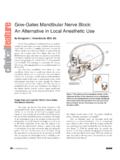Transcription of Spread of Dental Infection - dhed.net
1 TPractical Hygiene13 September/October 1997he healthy body usually lives in balance with a number of resident normalflora. However, pathogens can invadeand initiate an infectious involving the teeth or associ-ated tissues are caused by oral pathogensthat are predominantly anaerobic andusually of more than one can be of Dental origin or froma nonodontogenic source. Those of dentalorigin usually originate from progressivedental caries or extensive periodontal disease. Pathogens can also be introduceddeeper into the oral tissues by the traumacaused by Dental procedures, such as thecontamination of Dental surgical sites ( , tooth extraction) and needle tracksduring local anesthetic consists of removal of thesource of Infection , systemic antibiotics,and area Dental infections are secondaryinfections incited by an Infection in thetissues surrounding the oral cavity, such asthe skin, tonsils, ears, or sinuses.
2 Thesenonodontogenic sources of infectionsmust be diagnosed and treated referral to the patient s physicianwill prevent further Spread and potentialcomplications. However, many peopletoday do not have adequate Dental ormedical infections can result in dif-ferent types of lesions, depending on thelocation of the Infection and the type oftissue involved. An oral abscess occurswhen there is localized entrapment ofpathogens, with suppuration from a den-tal Infection in a closed tissue space (Figures 1 and 2). A periapical abscessformation can occur with progressivecaries, when pathogens invade the pulpand the Infection spreads can become entrapped in deeppockets with severe periodontal diseaseor around an erupting third molar, caus-ing periodontal abscess or pericoronitis, formation may notbe detectable radiographically during theearly the later stages of infec-tion, abscess formation can also lead tothe formation of a passageway, or fistula,in the skin, oral mucosa.
3 Or even bone inorder to drain the Infection and suppu-rate at the surface (Figures 1 and 2). Theinfectious process causes the overlyingtissues to undergo necrosis, forming acanal in the tissue, with a stoma. If the Dental Infection is surrounded by the alve-olar bone, it will break down the bone inits thinnest portion (either the facial or lin-gual cortical plate), following the path ofleast soft tissue over a fistula in thealveolar bone may also have an extraoralor intraoral pustule a small, elevated,circumscribed, suppuration-containinglesion of either the skin or oral position of the pustule is largelydetermined by the relationship betweenthe fistula and the overlying muscleattachments.
4 Again, the Infection will fol-low the path of least resistance (Table 1).The muscle attachments to the bonesserve as barriers to the Spread of infec-tion, unlike the other facial soft of the face and neck canalso occur with Dental infections , resultingin the diffuse inflammation of soft clinical signs and symptomsare pain, tenderness, redness, and diffuseedema of the involved soft tissue space,causing a massive and firm swelling(Table 2). There may also be dysphagia orrestricted eye opening, if the cellulitisSpread of Dental InfectionMargaret J.
5 Fehrenbach, RDH,MS, is an Oral Biologist, Dental Hygienist, and Educa-tional Consultant, Seattle,Washington, and a Clinicianwith Woodall and Associates,Fort Collins, W. Herring, PhD, is anAnatomist, Researcher, andProfessor of Orthodonticsat the School of Dentistry,University of Washington,Seattle, J. Fehrenbach, RDH, MS Susan W. Herring, PhD5 Dental Infection can be a serious complication forpatients, especially those without adequate Dental or med-ical care. This modified excerpt from Illustrated Anatomyof the Head and Neckdiscusses Dental Infection lesions.
6 Italso examines the Spread of Dental infections from theteeth and associated oral tissues to vital tissues ororgans, as well as prevention and management of thispotentially life-threatening complication. Discussion ofmedically compromised patients is also article is a modified excerpt from:Fehrenbach MJ, Herring SW. IllustratedAnatomy of the Head and , PA: WB Saunders Com-pany; 1996. The text, figures, and mod-ified illustrations are reprinted withpermission of the publisher. occurs within the pharynx or orbitalregions, respectively.
7 Usually, the infec-tion remains localized and a facial abscesscan form that, if not initially treated, maydischarge upon the facial surface. Withouttreatment, cellulitis could Spread to theentire facial area, due to perforation ofthe surrounding bone. Cellulitis is treatedby administration of antibiotics, andremoval of the cause of type of lesion related to den-tal infections is osteomyelitis, an inflam-mation of the bone locally involve any bone in the bodyor be generalized (Figure 3). This inflam-mation develops from the invasion of thetissue of a long bone by pathogens usuallyfrom a skin or pharyngeal Infection .
8 Forthose involving the jaw bones, thepathogens are most often from a periapi-cal abscess, from an extension of cellulitis,or from contamination of surgical sites2(Figure 3). Osteomyelitis most frequentlyoccurs in the mandible and rarely in themaxilla, because of the mandible s thickercortical plates and reduced of osteomyelitis leadsto bone resorption and sequestra forma-tion. Bone damage is easily detected byradiographic , evi-denced by burning or prickling, maydevelop in the mandible if the infectioninvolves the mandibular canal that carriesthe inferior alveolar , 6 Localizedparesthesia of the lower lip may occur ifthe Infection is distal to the mental fora-men where the mental nerve exits.
9 Treat-ment consists of drainage, surgicalremoval of any sequestra, antibioticadministration, and, in some patients, theadditional use of hyperbaric COMPROMISEDPATIENTSN ormal flora usually do not create aninfectious process. If, however, the body snatural defenses are compromised, thenthey can create opportunistic compromised individualsinclude those with AIDS, Type I diabetes,and those undergoing radiation patients, due to their medical his-tory, have a higher risk of complicationsfrom Dental infections . Patients in this cat-egory include those at risk for OF Dental INFECTIONSMany infections that initially start in theteeth and associated oral tissues can havesignificant consequences if they Spread tovital tissues or organs.
10 Usually a localizedabscess establishes a fistula in the skin, oralmucosa, or bone, allowing natural drainageof the Infection and diminishing the risk ofthe Infection s Spread . This process can beinterrupted by Dental or medical Hygiene14 September/October 1997 Figure periodontal abscess of the maxillary central incisor with fistula and stomaformation (probe inserted) in the maxillary formation can lead to formation of a fistula in order to drain theinfection. (Photography courtesy of Dr. Michael A. Brunsvold.)Figure of the mandible, with , a Dental Infection will spreadto the paranasal sinuses, through the bloodsystem, or through the TO THE PARANASALSINUSESThe paranasal sinuses of the skull canbecome infected through the direct spreadof Infection from the teeth and associatedoral tissues, resulting in a secondary sinusi-tis.





